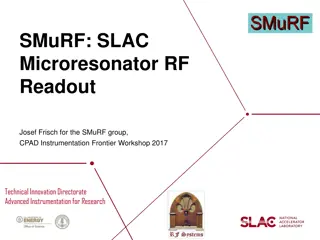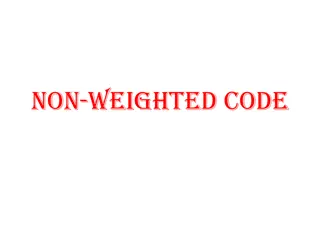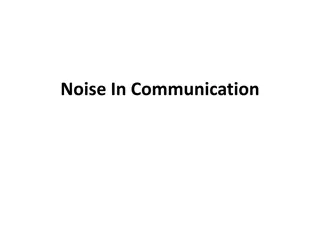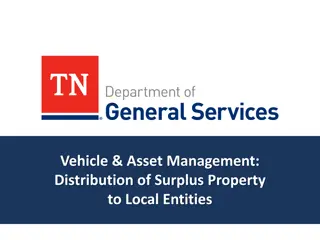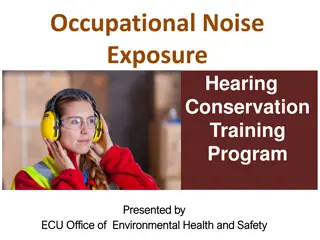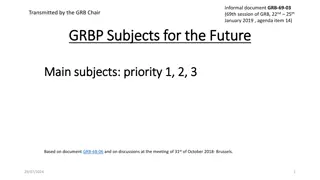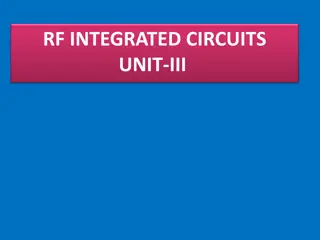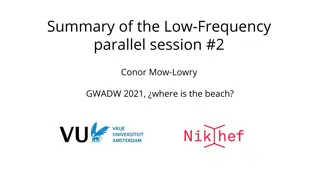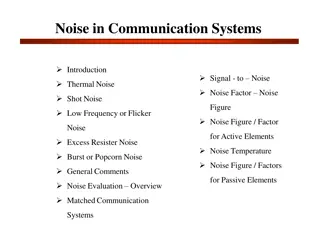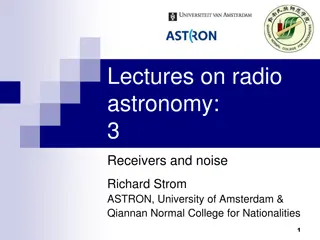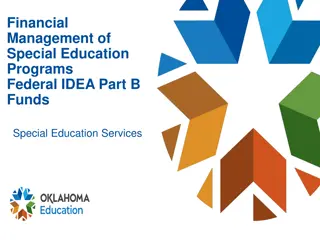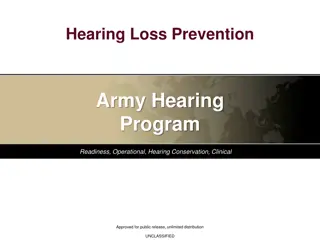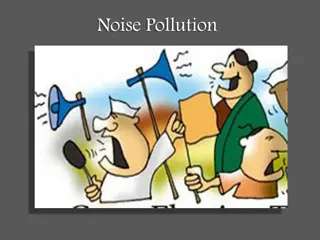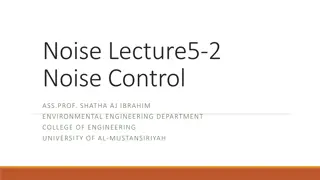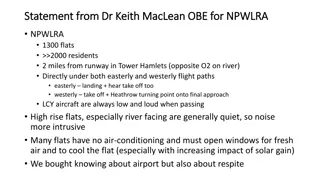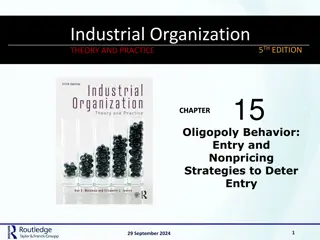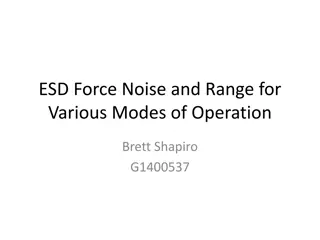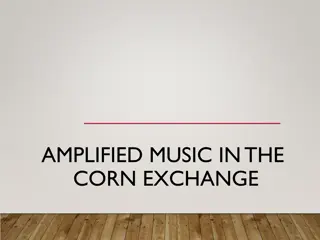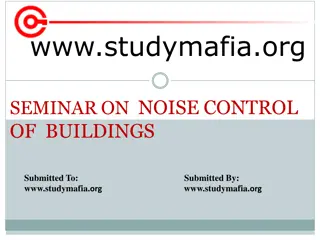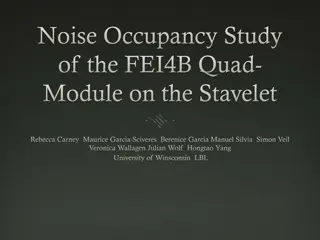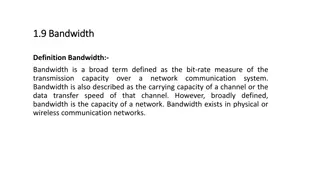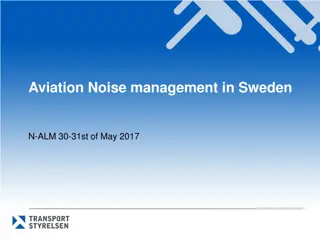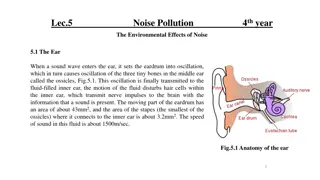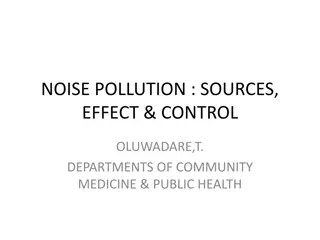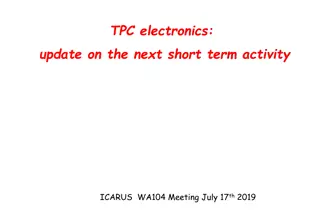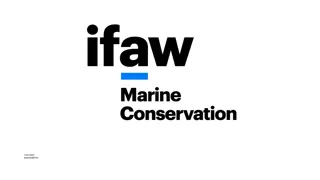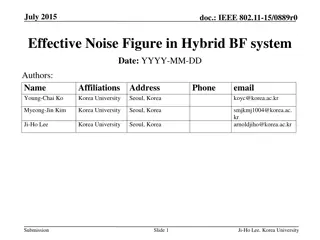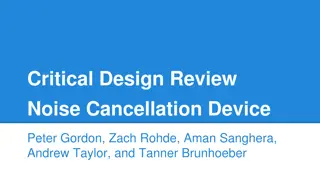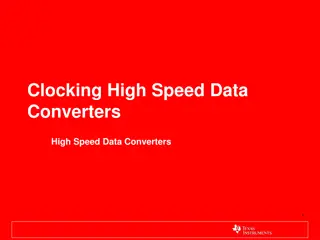Frequency Weighting in Noise Pollution Measurement
Frequency weighting is essential in noise pollution measurement to reflect how the human ear perceives noise. The A, C, and Z weightings are commonly used to represent different frequency responses. A-weighting covers the audible frequencies where the human ear is most sensitive, while C-weighting i
3 views • 7 slides
SMuRF: SLAC Microresonator RF Readout
SMuRF group at SLAC developed a cutting-edge RF readout system for cryogenic micro-resonators used in research. The system features cold resonators tuned with TES current and a flux ramp to eliminate 1/f noise. Key technical challenges include noise, linearity, wide bandwidth, and computation power.
4 views • 16 slides
Non-Weighted Codes and Excess-3 Code in Binary Systems
Explore non-weighted binary codes like Excess-3 code, learn how to convert decimal numbers to XS-3 code, advantages and disadvantages of BCD codes, and steps to convert Excess-3 code to binary. Discover the intricacies of binary coding systems with practical examples.
5 views • 55 slides
Timber Acoustic Wall Panels: A Versatile Solution for Noise Reduction in Open Of
In the ever-evolving landscape of modern office design, creating workspaces that foster productivity, \ncollaboration, and employee well-being is paramount. However, the transition to open office \nenvironments, characterized by expansive layouts and minimal physical barriers, has introduced \nchall
7 views • 2 slides
Noise in Communication Systems
Noise in communication refers to unwanted energy that interferes with signal reception and transmission. It can be categorized as external or internal noise, each with various subtypes like atmospheric noise and shot noise. Recognizing and managing different types of noise is essential for ensuring
1 views • 8 slides
Excess Costs in Special Education
Excess costs in special education refer to additional expenses incurred by Local Educational Agencies to provide services to children with disabilities. These costs go beyond the average per-student expenditure on general education. The calculation of excess costs ensures that federal IDEA Part B fu
1 views • 11 slides
Pipeline Management in Regional Financial Workshops
Define and discuss pipeline management in the context of regional financial workshops, including the definition of pipeline, timing implications, reasons for excess pipeline, and strategies for addressing excess pipeline. Key topics covered include pipeline definition, timing implications, causes of
0 views • 19 slides
Centralized Excess Property Furniture Catalog and Warehouse Information
Detailed information about excess furniture stored at the Centralized Excess Property Operation's warehouse in Beltsville, MD. Includes a range of furniture items such as desks, credenzas, work stations, end tables, conference tables, storage cabinets, chairs, and more. Contact Leslie Fisher for app
0 views • 15 slides
Vehicle & Asset Management: Surplus Property Distribution to Local Entities
The Surplus Property Program, operated by General Services, manages the redistribution of surplus property purchased with state funding to various entities such as state agencies, local governments, and non-profit organizations. Additionally, the Federal Excess/Surplus Property Program oversees the
1 views • 16 slides
Managing and Navigating WinRMS: How to Manage Noise in Downloads
Explore strategies presented by industry experts on managing noise in WinRMS downloads, including investigations into causes such as VISTA, FMS, PAID, and Fiscal Service. Learn about the impact of noise, types of alerts, and effective resolution techniques for a smoother data management process.
0 views • 40 slides
Acoustics of Entertainment and Sports Venues: Draft IOA Good Practice Guide
This document introduces the Draft Revised IOA Good Practice Guide for acoustics in entertainment and sports venues. It covers the rationale, scope, regulatory framework, risk assessment, noise assessment examples, and the need for revision due to changes in the regulatory landscape since 2003. The
0 views • 31 slides
Occupational Noise Exposure and Hearing Conservation Training Program
Learn about the Occupational Noise Exposure and Hearing Conservation Training Program presented by the Office of Environmental Health and Safety at ECU. This program aims to educate workers about the risks of noise-induced hearing loss, the importance of prevention, and the selection of appropriate
1 views • 20 slides
Future Subjects in Vehicle Regulations: GRBP Priorities and Considerations
The document GRB-69-03 discusses priority topics for future vehicle regulations, including tyre noise limits, track alignment discrepancies, tolerances for defining parameters, anti-tampering measures, pass-by tests, and next-generation testing methods. It also addresses pedestrian horn noise reduct
0 views • 13 slides
Noise in RF Integrated Circuits: Thermal and 1/f Noise
Noise, an unwanted input, limits a system's ability to process weak signals. Sources of noise include random noise in resistors and transistors, mixer noise, undesired cross-coupling noise, and power supply noise. Thermal noise, caused by thermal agitation of charge carriers, is also known as Johnso
1 views • 49 slides
Insights from ET-ISB Workshop on Low-Frequency Noise and GWADW 2021
The ET Instrument Science Board held a workshop focusing on addressing key challenges related to low-frequency noise in gravitational wave detectors. Experts discussed topics such as mirror temperature, dealing with low-frequency noise realities, and facility limits. The workshop highlighted the sig
0 views • 13 slides
Advanced Understanding of Low-Frequency Noise in Instrumentation
Understanding low-frequency noise in instrumentation has advanced significantly, emphasizing the need for an integrated approach to predict and mitigate such noise. Recent studies show that low-frequency noise in third-generation instruments is exceptionally better than in second-generation detector
0 views • 11 slides
Noise in Communication Systems
Noise in communication systems refers to unwanted signals that interfere with desired signals, originating from various sources such as interference from human-made sources and naturally occurring random noise. This noise can arise from factors like cross talk, power supplies, ignition systems, and
0 views • 19 slides
Receivers and Noise in Radio Astronomy
Discover the challenges faced in radio astronomy due to noise, with the signal often indistinguishable from background noise. Learn about receiver sensitivity issues, minimizing thermal noise, and mitigating atmospheric effects to improve observation quality. Explore the essential elements of telesc
0 views • 55 slides
Financial Management of Special Education Programs
Federal IDEA Part B funds support special education programs, helping LEAs implement IDEA. These funds must be used for allowable purposes like special education services, appropriate technology, and early intervening services. It's essential to use IDEA Part B funds to pay for excess costs and supp
1 views • 105 slides
Protect Your Hearing: Strategies for Prevention
Strategies for minimizing noise-related threats in operational environments are crucial to prevent permanent hearing loss. Understanding the risks of loud noise exposure, utilizing hearing protection, undergoing regular audiometric testing, and maintaining noise records are essential components of t
0 views • 22 slides
Noise Pollution: Sources, Terminology, and Measurement
Noise pollution is defined as undesirable sounds that disrupt human and animal life. This article explores the sources of noise pollution, terminology used in its measurement, and its impact on urban environments. Major sources include traffic noise, industrial machinery, and household activities. U
1 views • 26 slides
Noise Control Methods in Environmental Engineering
Explore the concepts of noise control in environmental engineering, focusing on mufflers, reactive mufflers, and noise control in the transmission path. Learn about absorptive and reactive mufflers, their principles, and applications. Discover how barriers and panels can effectively reduce noise tra
0 views • 9 slides
Concerns Regarding Airplane Noise Impact on Residents in Tower Hamlets
Dr. Keith MacLean OBE provides a statement on the impact of airplane noise on over 2000 residents living in 1300 flats within a 2-mile radius of a London airport in Tower Hamlets. The residents face challenges with noise disturbance from easterly and westerly flight paths, with proximity to both lan
0 views • 10 slides
Determination of Bicarbonate in Blood Using Back Titration
Back titration is an analytical chemistry technique used to determine the concentration of an analyte, such as bicarbonate in blood. This method involves reacting the analyte with an excess reagent, followed by back-titrating the remaining excess and relating it to the original sample's concentratio
0 views • 21 slides
Oligopoly Behavior: Excess Capacity Models and Entry Deterrence Strategies
Examine the concept of excess capacity models in oligopoly behavior, where a monopolist may strategically deter entry by either building excess capacity or expanding current production facilities in response to potential entrants. Explore scenarios involving sunk costs, marginal costs, pricing strat
0 views • 37 slides
ESD Force, Noise, and Range in Various Modes
This content discusses ESD force, noise, and range in different modes of operation, presenting assumptions, possible operation modes, and details on maximum range mode and noise characteristics. It explores concepts like control voltage offset, force noise calculations, and practical applications fo
0 views • 9 slides
Noise Control Measures and Community Preferences at the Corn Exchange
Various images and references discuss the history of amplified music events at the Corn Exchange, noise complaints leading to control methods by the FTC, impacts on events and community preferences post-control, and survey findings on participant demographics, noise effects, and desired public event
0 views • 19 slides
Noise Control Strategies for Buildings: A Comprehensive Seminar Overview
Explore the impact of noise on health, methods to control noise in buildings, and various techniques including room acoustics, wall and floor construction, space planning, HVAC soundproofing, and more. Understand the importance of noise reduction for overall well-being and effective sound management
0 views • 20 slides
Noise Occupancy Study of FEI4B Quad Module: Troubleshooting and Solution
This study delves into the noise occupancy of the FE-I4B chips on the quad module mounted on the Stavelet, addressing unexpected noise increases, problem tracing, and cross-checking between USBpix and RCE. Early studies pinpoint temperature control and suspected unstable grounding. The comparison be
0 views • 21 slides
Bandwidth, Channel Capacity, and Noise in Communication Networks
Bandwidth is a crucial aspect of network capacity, describing the data transfer speed and carrying capacity of a channel. Channel capacity involves factors like data rate, bandwidth, noise, and error rate. Noise sources include thermal noise, impulse noise, and delay distortion, impacting signal qua
0 views • 5 slides
Aviation Noise Management Strategies in Sweden
Aviation noise management in Sweden focuses on a balanced approach with four principal elements: noise reduction at the source, adherence to ICAO noise standards, differentiated landing fees, and operating restrictions. Competent authorities such as the Swedish Environmental Protection Agency and Sw
1 views • 4 slides
The Impact of Aircraft Noise on Health - Recent Update
This report provides a six-month update on recent research findings regarding aircraft noise and its effects on health. Saucy et al. studied the association between aircraft noise exposure and cardiovascular mortality, particularly at night, with significant findings related to increased odds of nig
0 views • 20 slides
Environmental Effects of Noise Pollution on Human Health
When a sound wave enters the ear, it sets off a chain reaction that can lead to various health issues such as depression, fatigue, insomnia, and decreased cognitive function. Noise pollution affects individuals at different levels - auditory, biological, and behavioral, impacting performance, physio
0 views • 15 slides
Noise Pollution: Sources, Effects, and Control
Noise pollution is a significant environmental issue resulting from unwanted sounds in various settings. This article delves into the properties of sound, measurement techniques, sources of noise, effects of noise exposure, and strategies for control and mitigation, shedding light on the impact of n
0 views • 16 slides
Update on TPC Electronics Activities - July 2019
The upcoming short-term activities for ICARUS WA104 meeting on July 17th, 2019, at TPC Electronics include installation of cables, refurbishment of defective modules, and addressing excess noise issues in mini-crates. Detailed plans for interventions at FNAL from July 24th onwards involve repair act
0 views • 7 slides
Addressing Underwater Noise Pollution in EU Waters: Urgent Action Needed
Whales, dolphins, and other marine life are severely impacted by underwater noise pollution caused primarily by shipping activities in EU waters. Urgent implementation of stricter regulations based on IMO guidelines is essential to reduce noise levels and protect marine ecosystems. Recommendations i
0 views • 4 slides
Noise Figure Analysis in Hybrid Beamforming Systems
This document discusses the theoretical study of noise figure (NF) and gain in hybrid beamforming systems, focusing on the impact of additional RF blocks, such as phase shifters and combiners, on noise figure calculations. It explains how the received signals from multiple antennas are phase-correct
0 views • 11 slides
Excess Hour Fees in Florida Universities
Florida universities implement excess hour fees to encourage efficient completion of undergraduate degree programs. The fees are applied when students exceed a certain number of credit hours, aiming to incentivize timely degree completion. The policy includes provisions for notifying students, count
0 views • 18 slides
Critical Design Review Noise Cancellation Device
This project aims to create a portable device for reducing HVAC equipment noise levels. With objectives like noise reduction by at least 10 dB in specific frequency ranges, this device will utilize key technologies such as Teensy, Electret Microphone Amplifier, and more. The noise cancellation algor
0 views • 13 slides
Maximizing SNR in High-Speed Data Converters
Strategies for maximizing the Signal-to-Noise Ratio (SNR) in high-speed data converters. Learn about key factors affecting SNR, such as quantization noise, clock jitter, and thermal noise. Understand methods to increase SNR by managing signal power, noise sources, and ADC performance. Discover how t
0 views • 51 slides

